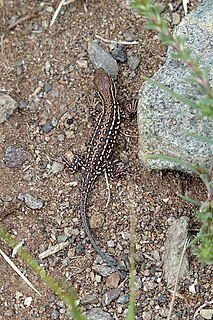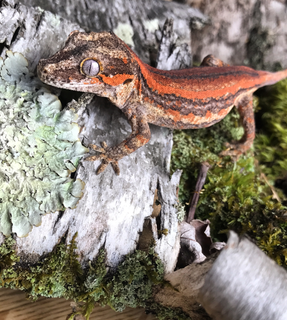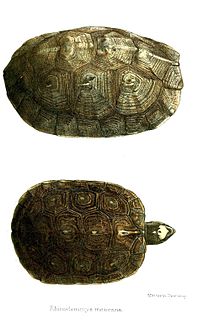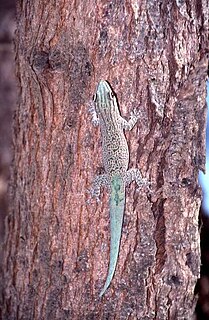 W
WAchalinus spinalis, commonly known as Peters' odd-scaled snake, the Japanese odd-scaled snake, the Japanese ground snake or the grey burrowing snake, is a species of snake in the family Xenodermatidae.
 W
WThe Argentine snake-necked turtle, also known commonly as the South American snake-necked turtle is a species of turtle in the family Chelidae. The species is known for the long neck to which its common names refer. Despite appearances, the Argentine snake-necked turtle is probably more closely related to the mata mata than to the Australian snake-necked turtles in the genus Chelodina. H. tectifera is found in northern Argentina, Uruguay, Paraguay, and southern Brazil. Not much is known about it, as it has not been extensively researched. It is a popular pet in the exotic pet trade.
 W
WBoiga barnesii is a species of cat snake endemic to Sri Lanka. It is known as the Barnes' cat snake in English and panduru mapila-පදුරු මාපිලා in Sinhala. It is a member of the snake family Colubridae. It is distributed in the lowlands and midlands up to ~600m above sea level, with known localities include Matale, Kandy, Gannoruwa, Gampola, Ambagamuwa, Balangoda, Labugama and Sinharaja Rain Forest. Barnes' cat snake is mainly a forest-dwelling species but may occasionally be found in human habitats. It is the smallest cat snake in Sri Lanka and grows up to a maximum of 600 mm (24 in) in snout-vent length. Being a nocturnal and an arboreal hunter, it mainly feeds on agamid lizards and geckos. The day time is usually spent inside a tree hole or a crevice. It’s a very timid and a mildly venomous snake and rarely attempts to bite.
 W
WThe Burmese peacock softshell turtle is a species of softshell turtle in the Trionychidae family. It is one of five species in the genus Nilssonia.
 W
WThe Canterbury gecko is a gecko found in the South Island of New Zealand. It is also known by the Maori names Waitaha gecko and Moko-pāpā, and as the Brown gecko. They were earlier placed in a different genus and called Hoplodactylus brunneus before further study split the genus Hoplodactylus into six genera, with some groups close to the former Hoplodactylus maculatus “Canterbury” being assigned to the new genus Woodworthia.
 W
WCarlia rhomboidalis, the blue-throated rainbow-skink, is a species of skink in the genus Carlia. It is endemic to Queensland, Australia.
 W
WThe common litter skink is a species of lizard in the family Scincidae. It is endemic to New Caledonia.
 W
WConiophanes piceivittis, known commonly as the black-striped snake or Cope's black-striped snake, is a species of small snake in the subfamily Dipsadinae of the family Colubridae. The species is endemic to Central America and Mexico, and is found in a wide range of habitats.
 W
WThe East African spiny-tailed lizard, also commonly known as the dwarf sungazer or the tropical girdled lizard, is a species of arboreal or rupicolous (rock-dwelling) lizard endemic to East Africa.
 W
WEremias argus is a species of lizard found in Mongolia, China, Korea, and Russia.
 W
WEurydactylodes vieillardi, sometimes known commonly as Bavay's gecko or Vieillard's chameleon gecko, is a species of lizard in the family Diplodactylidae. The species is endemic to Grande Terre in New Caledonia.
 W
WThe gargoyle gecko or New Caledonian bumpy gecko is a species of gecko found only on the southern end of the island of New Caledonia. Its habitat is threatened by deforestation on the island. This gecko, along with several other Rhacodactylus species are being considered for protective measures by CITES, which would put restrictions on their exportation. This gecko was first described by Bavay in 1869.
 W
WThe Gila monster is a species of venomous lizard native to the southwestern United States and the northwestern Mexican state of Sonora. A heavy, typically slow-moving lizard, up to 60 cm (2.0 ft) long, the Gila monster is the only venomous lizard native to the United States and one of only two known species of venomous lizards in North America, the other being its close relative, the Mexican beaded lizard. Although the Gila monster is venomous, its sluggish nature means it represents little threat to humans. However, it has acquired a fearsome reputation, and is sometimes killed despite being protected by state law in Arizona.
 W
WHoplocephalus stephensii is a species of highly venomous tree snake in the family Elapidae. Its common name is Stephens' Banded Snake. The species is endemic to Australia.
 W
WThe Leeward Island racer is a species of snake in the family Colubridae. The species is found in Anguilla, Saint Barthélemy, and probably extinct on Sint Maarten.
 W
WLoxopholis rugiceps is a species of lizard in the family Gymnophthalmidae. It is found in Colombia and Panama.
 W
WThe marble-throated skink is a species of skink found in New Caledonia.
 W
WThe Mexican spotted wood turtle or Mexican spotted terrapin is a species of turtle in the family Geoemydidae.
 W
WMniarogekko chahoua commonly known as the mossy New Caledonian gecko, short-snouted New Caledonian gecko, Bavay's giant gecko, or mossy prehensile-tailed gecko, is an arboreal gecko found natively on the southern portion of the island of New Caledonia and on the outlying islands of Île des Pins.
 W
WOplurus fierinensis, also known as the Anzamala Madagascar swift or Madagascar blue iguana, is a saxicolous iguana endemic to Madagascar.
 W
WOplurus saxicola is a saxicolous iguana. The name of this species, saxicola, comes from the Latin saxum, meaning stone or rock, as they live within that environment.
 W
WThe Thicktail day gecko is a species of gecko found in Madagascar.
 W
WGarnier's skink is a species of skink found in New Caledonia.
 W
WDeplanche's shiny skink is a species of skink found in New Caledonia.
 W
WThe spectacled hooded snake, also known commonly as the Port Lincoln snake, is a species of venomous snake in the family Elapidae. The species is native to central-southern Australia. There are three recognized subspecies.
 W
WSteudner's dwarf gecko, also commonly known as the Algerian sand gecko and Steudner's pigmy gecko, is a species of lizard in the family Gekkonidae. The species is native to North Africa and the Middle East.
 W
WThe southern whiptailed skink is a species of skink found in New Caledonia. Tropidoscincus variabilis is a medium-sized, long-limbed and long-tailed skink with strong ontogenetic change in coloration. They are more brightly colored as juveniles. They live primarily in forests and heathlands. Mature males and females are roughly the same size, but females have longer bodies, shorter heads and limbs, and a less brightly orange venter.Females lay 2-4 eggs in summer, and young hatch in late summer. More than one year of growth is required to attain maturity. They eat a large variety of invertibrates, particularly spiders and crickets. Juveniles eat more spiders, bugs and isopods than adults.